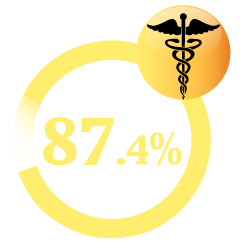In 2007, 19.3 million Americans needed treatment for alcohol dependency.
However, not everyone who needs treatment receives it.
Sadly, the vast majority of individuals who need treatment for alcoholism – 87.4% – did not receive help because they did not believe that they needed it.
If a loved in is struggling with alcoholism, your decision to help them seek treatment is critical to their health and long-term sobriety.
[separator top=”40″ style=”single”]
Download the Free Guide to Alcoholism Treatment E-Book[separator top=”40″ style=”single”]
What are the treatment options for alcoholism?
Alcohol rehabilitation centers are one of the most popular and effective treatment options for alcoholism. Inpatient rehab centers are especially beneficial for individuals who need time away from the pressures of daily life, such as work stress or a difficult family situation, which may be contributing to their alcohol abuse.
Additionally, in-patient centers provide individuals with a “clean break” from the habits, people and places that fueled their alcohol abuse. In addition to inpatient rehab centers, other treatment options include outpatient care and Alcoholics Anonymous meetings.
What is the goal of alcohol treatment?
Long-term abstinence is the goal of alcohol treatment. In order to achieve this goal, most treatment programs focus on smaller, sequential steps. The first step is detoxification,
which may require medical intervention in order to manage withdrawal symptoms. Following long-term abuse, withdrawal symptoms from alcohol can be severe.
They include shaking, hallucinations and confusion. For patient safety, detoxification typically occurs at a hospital or inpatient treatment center. Subsequent steps include establishing a treatment plan, undergoing psychological counseling and group therapy to address issues contributing to alcohol abuse, and participating in an outpatient treatment program to help reduce the risk for relapse.
These different milestones help individuals reach the overall goal of long-term sobriety.
How does Alcoholics Anonymous work?
Alcoholics Anonymous is a fellowship of alcoholics that helps individuals acknowledge their alcoholic addiction and take positive steps to support a sober life.
There are no dues or membership fees to be part of Alcoholics Anonymous; the only requirement is a desire to stop drinking. With local groups in thousands of communities, many individuals who complete an inpatient rehab program join their local AA group as part of their commitment to sobriety. AA membership is composed of individuals who have discovered and admitted that they cannot control their alcohol consumption.
AA members acknowledge alcoholism is an illness that can never be cured, but, by abstaining from alcohol consumption, it can be controlled. AA members follow the “24 hour” plan.
This means that rather than pledging to avoid drinking forever, members focus on their sobriety on day at a time. AA is closely associated with the 12-step program as well as the belief that no one can “force” another person to stop drinking; the individual who is abusing alcohol must make that decision for themselves.
When is treatment at a residential facility necessary?
While some individuals may able to successfully address their alcohol dependence with outpatient care and group therapy, for many other individuals, treatment at a residential inpatient program is necessary to kick-start their journey to sobriety.
For a serious alcohol problem, treatment at a residential facility is very beneficial. In addition to providing an important “break” from an individual’s past life of alcohol abuse, treatment facilities also help integrate individuals into group therapy, Alcoholics Anonymous, activity therapy, and educational programs. Residential facilities help individuals establish new patterns of behavior that support an alcohol-free lifestyle.
[separator top=”40″ style=”single”]
Download the Full Guide to Alcoholism Treatment[separator top=”40″ style=”single”]



